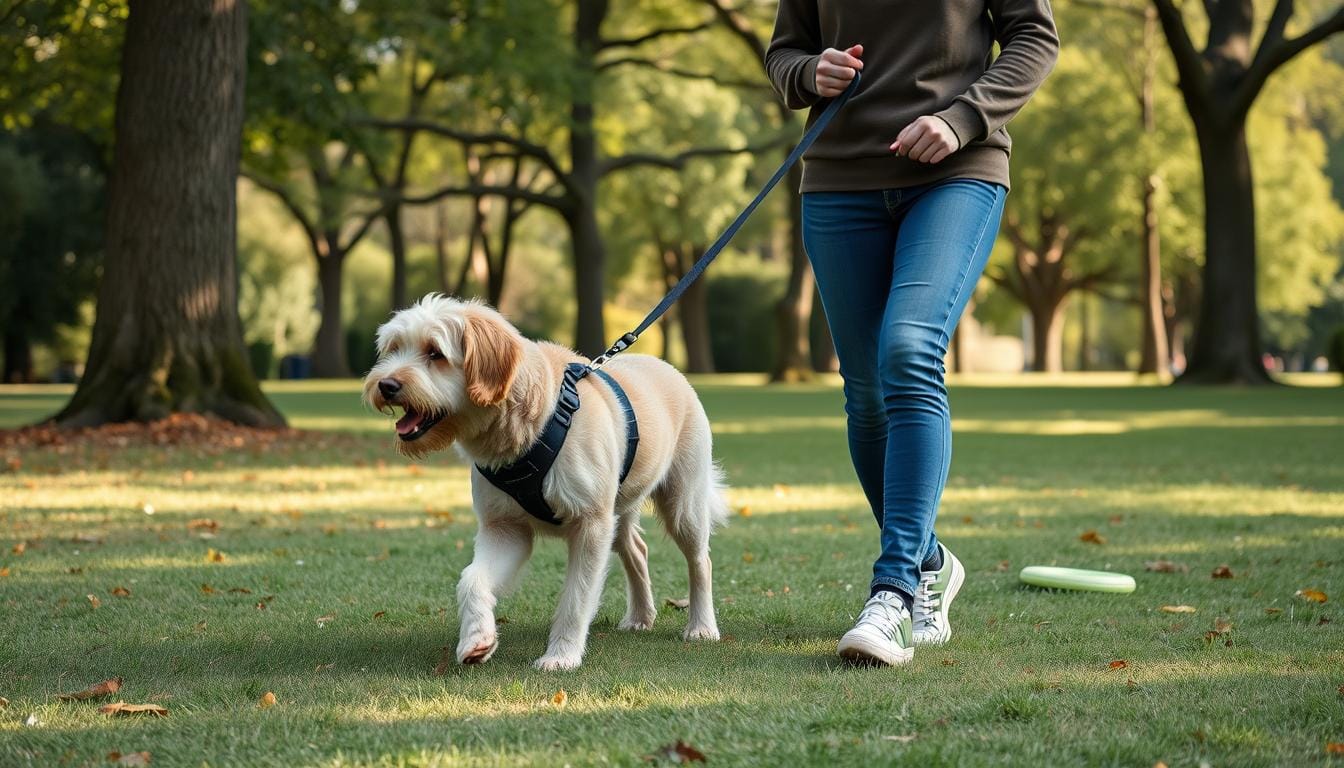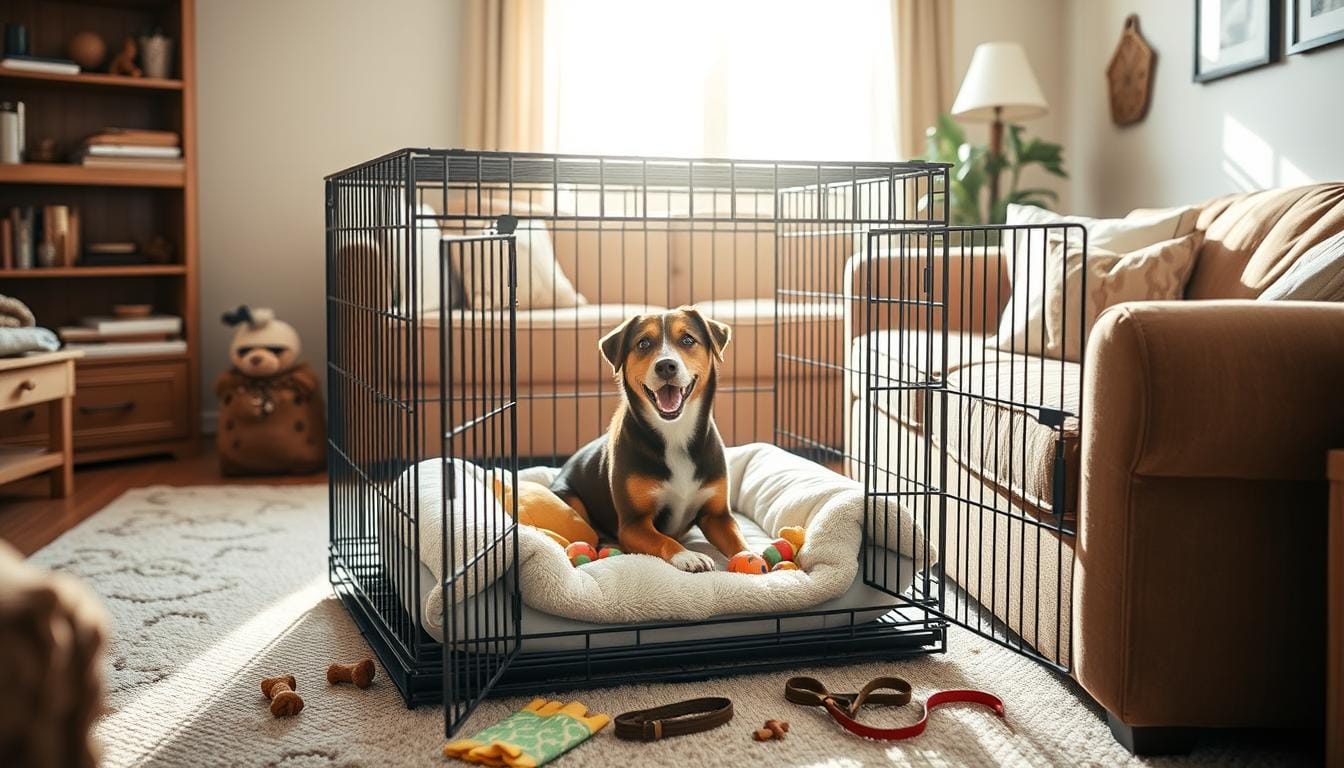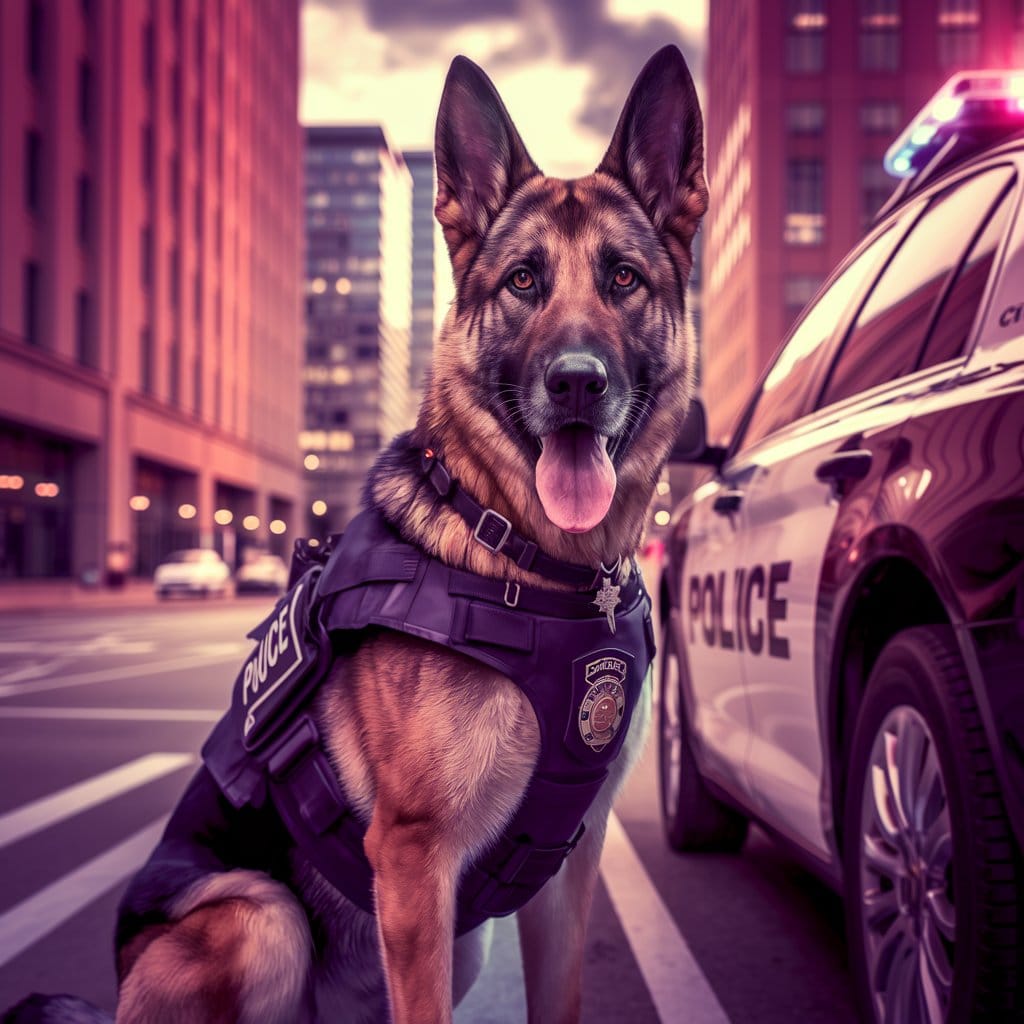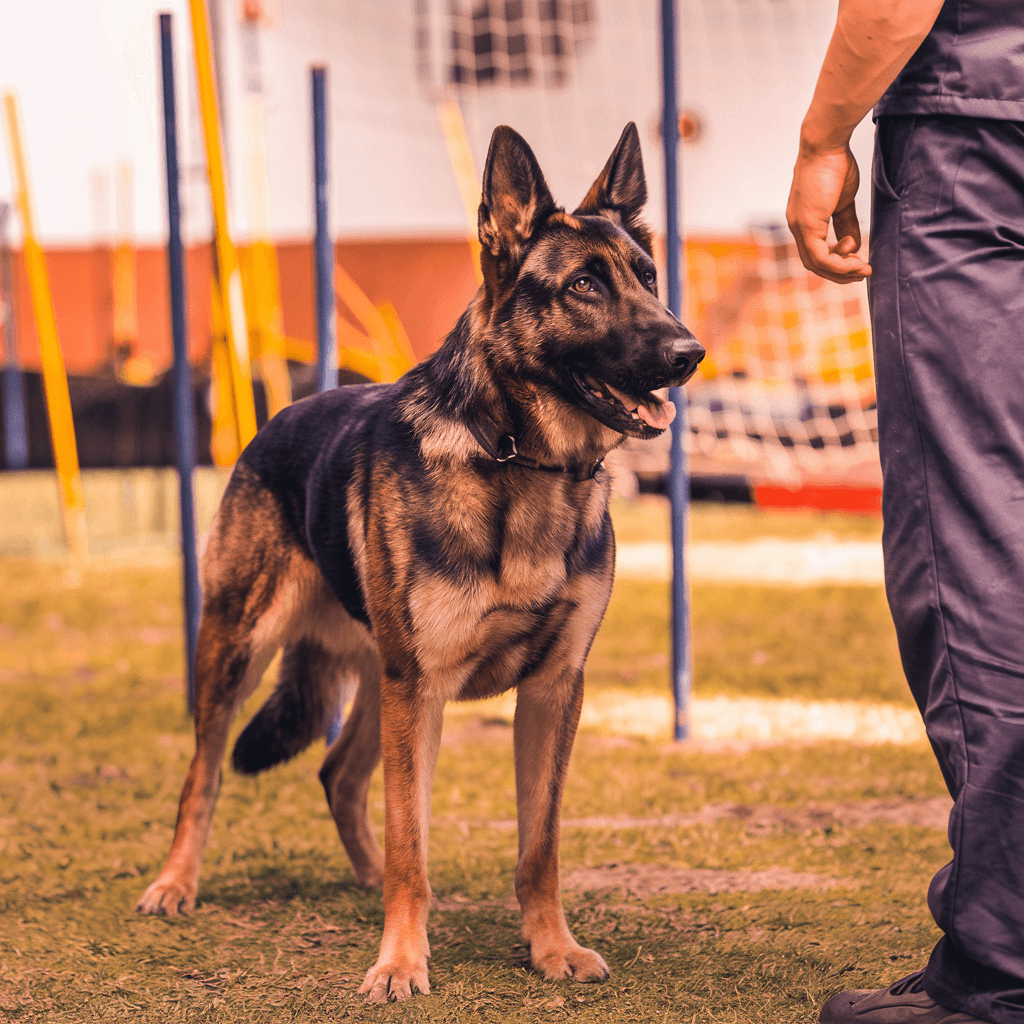Dogs can’t tell us when they’re feeling anxious, but their behavior speaks volumes. As pet parents, we need to tune into our furry friends’ body language and actions to spot dog stress signs. Understanding anxious dog behavior is key to keeping our pets happy and healthy.
Our canine companions experience stress in various ways. Fear, phobias, and anxiety are the main types of stress dogs face. Each type triggers different reactions, from subtle changes to more obvious signs. By learning to read these cues, we can better support our dogs through tough times.
When dogs feel stressed, their bodies react. You might notice increased panting, even when it’s not hot. Some dogs pace or shake, especially in unfamiliar places like the vet’s office. Others might yawn more often or lick their lips repeatedly. These are all pet behavior tips to watch for.
Changes in eating habits or sleep patterns can also signal stress. A normally hungry pup who turns down food or a usually calm dog who can’t settle at night might be feeling anxious. By paying attention to these shifts, we can step in and help our dogs feel safe again.
Key Takeaways
- Dogs show stress through physical and behavioral changes
- Common stress signs include panting, pacing, and excessive yawning
- Changes in eating and sleeping habits may indicate anxiety
- Understanding different types of stress helps in identifying symptoms
- Recognizing stress early allows for timely intervention and support
Understanding Dog Stress and Anxiety: The Basics
Our furry friends can feel stress and anxiety, just like us. It’s important to know the signs of dog anxiety and understand fearful behavior. This helps reduce pet stress and improves their well-being.
What Causes Stress in Dogs
Dogs get stressed for many reasons. Changes in their environment, new situations, or being away from their owners can upset them. Some breeds, like Siberian Huskies and Standard Poodles, might be more scared.
Noise, especially from thunderstorms or fireworks, is a big stressor for dogs.
Different Types of Stress Responses
Dogs show stress in different ways. They might have physical signs or change their behavior. These include:
- Tail wagging direction and speed
- Raised hackles
- Yawning or lip-licking
- Avoiding eye contact or showing “whale eye”
- Submissive grinning
Knowing these signs helps us see when our pets need help with anxiety.
Why Dogs Experience Anxiety
Anxiety in dogs can come from past traumas, not enough socialization, or genetics. Separation anxiety is a big issue for many dogs. Spotting anxiety early and acting fast is crucial.
If your dog shows aggression or fear, see a vet or behaviorist. They can check for health problems and help with treatment.
Physical Signs of Stress in Dogs
Dogs can’t tell us when they’re stressed, but their bodies do. It’s important to know dog stress signs to help them early. Let’s look at the physical signs that show when dogs are anxious.
One common sign is a faster heart rate and panting. You might see your dog breathing fast, even if they’re not moving much. They might also drool or shed more than usual.
Changes in a dog’s eyes can also tell us a lot. If their pupils are big or they show more white, it means they’re stressed. If they’re trembling or shaking without a reason, it’s a sign of distress.
Body language is another important clue. A stressed dog might hunch down or hide their tail. Some dogs get too active, while others freeze or become very still.
“Recognizing and addressing signs of stress in dogs early can prevent the escalation into more serious behavioral issues.”
Stress can also affect a dog’s bathroom habits. Look for unusual places where they mark with urine or trouble going to the bathroom. Changes in how much they eat can also be a sign of anxiety.
By knowing these signs, we can help our dogs during stressful times. Remember, watching them closely and acting fast is key to managing their stress.
Dog stress signs, calming dogs, pet behavior tips
It’s important to know when our dogs are stressed. They show it through different behaviors and physical signs. Let’s look at common stress signs and how to calm our dogs.
Common Behavioral Changes
Stressed dogs may act differently. They might pant a lot, yawn often, or lick their lips too much. Some dogs pace, whine, or bark more. Others might shed a lot or ignore what’s happening around them.

Warning Signs to Watch For
Watch out for serious stress signs. These include growling, showing teeth, or sudden aggression. Dogs might try to run away from stressful situations. In extreme cases, they could become destructive or even hurt themselves.
| Mild Stress Signs | Severe Stress Signs |
|---|---|
| Excessive panting | Aggression |
| Yawning | Fleeing |
| Pacing | Self-harm |
| Whining | Destructive behavior |
Immediate Response Techniques
Act fast if you see your dog stressed. Try to remove them from the stressful situation. Use relaxation techniques to calm them down. Positive reinforcement can also help.
Remember, if stress keeps happening, get professional help. A vet behaviorist can give specific advice to help your dog feel better.
Body Language Indicators of Canine Stress
It’s key for pet owners to know how dogs show stress. Dogs use body language to share their feelings. Spotting these signs helps us calm anxious dogs.
Facial Expressions and Eye Changes
A dog’s face tells a lot about their stress. Look for lip-licking, yawning, or seeing the whites of their eyes (whale eye). These signs often mean they’re feeling uneasy or scared.
Ear and Tail Positions
Ears back against the head often mean a dog is stressed or scared. Tail positions also show a dog’s mood. A tucked tail usually means they’re anxious or feeling submissive.
Body Posture Signals
A dog’s posture can tell us a lot about their stress. Watch for cowering, shifting weight, or becoming stiff. These are important signs to notice when checking your dog’s mood.
| Stress Indicator | Percentage of Stressed Dogs |
|---|---|
| Compulsive behaviors (licking, circling, drooling) | 38% |
| Aggressive behaviors (barking, destructive behavior) | 22% |
| Physical signs (tucked tail, trembling, dilated pupils) | 45% |
| Disengagement behaviors | 28% |
By understanding these body language signs, we can meet our dogs’ emotional needs. This helps reduce stress and improves their happiness.
Vocal Stress Signals in Dogs
Dogs show their feelings through different sounds. Knowing these sounds helps us calm them down when they’re stressed. Let’s look at the common signs of stress and how to understand them.
Too much barking is a big stress signal. While dogs bark normally, loud or long barking can mean they’re anxious. Whining shows they’re upset or need attention. Growling, often seen as aggressive, can also mean they’re scared or worried.
Some dogs bark or whine when they’re happy or trying to talk. It’s important to tell the difference between happy sounds and stressed ones. The situation helps us understand what they’re trying to say.
“Dogs have more than 30 ways to avoid stressful situations and calm themselves. Understanding these signals is crucial for pet behavior tips and management.”
Here’s a list of common stress sounds and what they might mean:
| Vocalization | Potential Meaning | Associated Behaviors |
|---|---|---|
| Excessive Barking | Anxiety, fear, or overstimulation | Pacing, restlessness |
| Whining | Distress, need for attention | Seeking proximity to owner |
| Growling | Fear, anxiety, or aggression | Raised hackles, stiff body posture |
| Howling | Loneliness, separation anxiety | Destructive behavior when alone |
By knowing these stress sounds, we can help our dogs feel better. It’s key to watch for these signs and act on them. This helps our dogs stay calm and happy.
Changes in Daily Routine and Habits
Spotting dog stress signs often means noticing changes in their daily life. We’ll look at areas where anxious behavior might show up. We’ll also share tips to help you spot and fix these changes.
Eating and Drinking Patterns
Stress can really mess with a dog’s appetite. Some might not want to eat, while others might eat too much. Also, watch if they drink a lot or hardly at all. These signs can point to stress.

Sleep Disturbances
Dogs, like people, can have trouble sleeping when stressed. You might see them having trouble relaxing, pacing at night, or sleeping too much. These sleep changes are key signs of stress.
Activity Level Changes
Stress can really change how active your dog is. Some might be too hyper, while others seem really tired. If your usually active dog is now bored or your lazy dog is restless, it could mean they’re anxious.
“Around the age of one to three years, pet parents begin noticing personality changes in their dogs.”
By watching for these changes, we can catch stress early and help our dogs. Remember, acting fast is crucial in managing anxiety and keeping our pets happy and healthy.
Environmental Triggers and Stressors
Dogs face many environmental triggers that can make them fearful. Knowing these stressors helps us reduce pet stress and help our dogs feel better. Our pets often react to things in ways we don’t expect.
Loud noises like fireworks or thunderstorms can really scare dogs. Moving to a new home can also stress them out. Dogs may feel uneasy around new people or animals, especially if they’ve had bad experiences before.
| External Stressors | Internal Stressors |
|---|---|
| New environments | Physical pain |
| Unfamiliar dogs or people | Unmet needs (e.g., lack of mental stimulation) |
| Loud noises | Allergies |
| Past negative experiences | Neurological disorders |
| Visits to the veterinarian | Breed-specific instincts |
Knowing what triggers stress in dogs helps us find ways to reduce it. We can limit their exposure to stressors or teach them how to cope. Regular exercise, socialization, and safe spaces at home can really help.
Physical Symptoms of Anxiety
Dogs can show physical signs of stress that go beyond behavior changes. Recognizing these dog stress signs is key to helping our furry friends. Let’s look at some common physical symptoms of anxiety in dogs.
Digestive Issues
Anxious dog behavior often impacts the digestive system. Dogs may experience:
- Loss of appetite
- Diarrhea or loose stools
- Vomiting in severe cases
Excessive Shedding
Have you noticed more dog hair than usual? Stress can cause dogs to shed more. This is often seen during vet visits or other stressful situations.
Physical Manifestations
Other physical symptoms of anxiety in dogs include:
- Excessive drooling
- Panting without physical exertion
- Trembling or shaking
- Dilated pupils
- Tucked tail
Understanding these physical signs helps us spot anxiety early. It’s crucial to rule out medical issues first. If you notice these symptoms, try some pet behavior tips to calm your dog. For persistent problems, consult with a vet or animal behaviorist.
“Anxiety in dogs is more common than we think. A study found that 72.5% of dogs show anxiety-related behaviors.”
Creating a Calm Environment
We know that calming dogs is essential for their well-being. By creating a peaceful atmosphere, we can provide effective dog anxiety relief. Let’s explore some relaxation techniques for dogs that can transform your home into a haven of tranquility.
First, designate a quiet space for your furry friend. This area should be free from loud noises and excessive foot traffic. Equip it with comfortable bedding and familiar toys to make it inviting.
Music can be a powerful tool for relaxation. Classical tunes have been shown to promote calm behavior in dogs. Consider playing soft melodies or white noise to drown out stressful sounds.
Physical comfort plays a big role in reducing anxiety. Many dogs benefit from pressure-applying garments like ThunderShirts®. These snug-fitting vests can help soothe your pet during stressful situations.
- Use pheromone diffusers like Adaptil® to mimic calming scents
- Maintain a consistent daily routine for feeding, exercise, and sleep
- Provide mental stimulation with puzzle toys and training sessions
- Incorporate regular grooming sessions for bonding and relaxation
Remember, each dog is unique. What works for one might not work for another. It’s important to observe your pet’s reactions and adjust your approach accordingly.
| Calming Aid | Benefits | Best For |
|---|---|---|
| Classical Music | Promotes relaxation | Noise-sensitive dogs |
| ThunderShirt® | Applies gentle pressure | Anxiety-prone dogs |
| Pheromone Diffusers | Mimics calming scents | Environmental stress |
| Puzzle Toys | Mental stimulation | Boredom-related anxiety |
By implementing these strategies, we can create a serene environment that supports our dogs’ emotional well-being. With patience and consistency, we’ll help our furry companions feel more relaxed and secure in their surroundings.
Prevention Strategies and Management
Keeping our pets happy and stress-free is very important. We’ll look at ways to change dog behavior and share tips to keep your dog calm and happy.
Daily Routine Adjustments
Having a daily routine is crucial for our pets’ happiness. Make sure to set regular times for meals, walks, and play. This routine gives your dog a sense of security and helps them know what to expect, reducing stress.
Exercise and Mental Stimulation
Exercise and mental games are key for your dog’s well-being. Try to do daily walks, play interactive games, and use puzzle toys. These activities help your dog stay active, sleep better, and feel happier.
Safe Spaces and Comfort Zones
It’s important to have a safe space for your dog. Create a quiet area with comfy bedding, favorite toys, and something with your scent. This spot is where your dog can relax when feeling stressed or anxious.
| Anxiety Management Strategy | Benefits | Implementation Tips |
|---|---|---|
| Consistent Daily Routine | Reduces uncertainty and stress | Set fixed times for meals, walks, and play |
| Regular Exercise | Releases pent-up energy and promotes relaxation | 30-60 minutes of activity daily, based on breed |
| Mental Stimulation | Prevents boredom and destructive behaviors | Use puzzle toys and training sessions |
| Safe Space Creation | Provides a calming retreat | Designate a quiet area with comfort items |
By using these strategies, we can make our dogs happier and reduce stress. Remember, being consistent is key to seeing lasting changes in your dog’s life.
When to Seek Professional Help
While many pet behavior tips and dog anxiety relief methods work, there are times when you need a pro. Knowing when to ask for help is key for your dog’s happiness and your own peace of mind.
- Your dog’s anxiety significantly impacts their quality of life
- Home management techniques fail to provide relief
- You notice severe or persistent anxiety issues
- There are sudden changes in behavior or physical symptoms
There are many ways to get professional help. Veterinarians are important for checking for health issues and might give anti-anxiety meds. Certified dog trainers or behaviorists can create special plans to help your dog with anxiety.
| Professional | Services |
|---|---|
| Veterinarian | Medical assessment, medication prescription |
| Dog Trainer | Behavior modification techniques, training plans |
| Animal Behaviorist | In-depth behavioral analysis, long-term strategies |
Remember, asking for help is not a failure. It’s a smart move to make sure your dog is happy and healthy. With the right guidance, you can find the best way to help your dog feel better and live a better life.
Conclusion
We’ve looked into dog stress signs and tips for pet behavior. Dogs can get stressed for many reasons, like feeling like the boss or picking up on our moods. It’s important to know the signs to keep them happy.
Signs include too much panting, barking, hiding, and changes in eating or sleeping. These are all clues that our dogs might be stressed.
Knowing why our dogs act out is the first step to fixing the problem. Issues like aggression, separation anxiety, and too much barking often come from stress. By teaching them, exercising them, and keeping their minds busy, we can make their lives better.
Helping dogs feel calm takes time and a few different steps. Setting routines, giving them safe places, and training them consistently can really help. Every dog is different, so what works for one might not work for another.
If your dog’s behavior doesn’t get better, getting help from a pro can be a big help. They can give you specific advice that fits your dog’s needs.
















